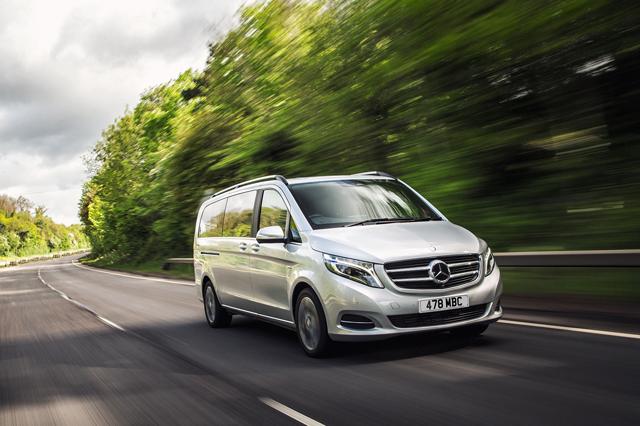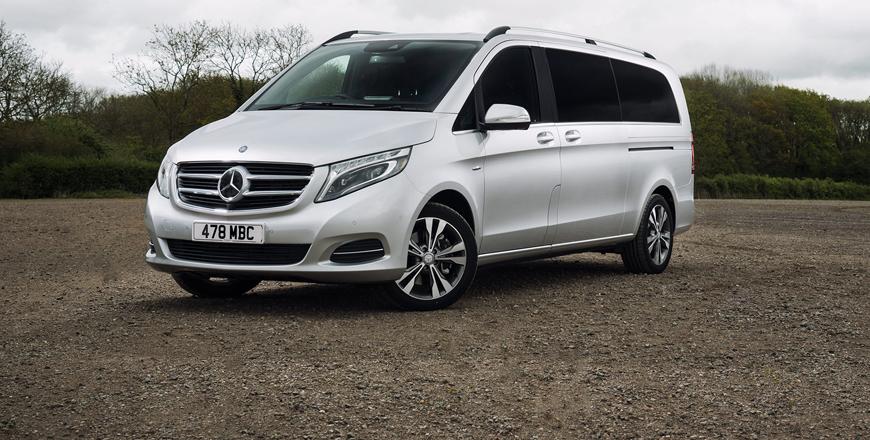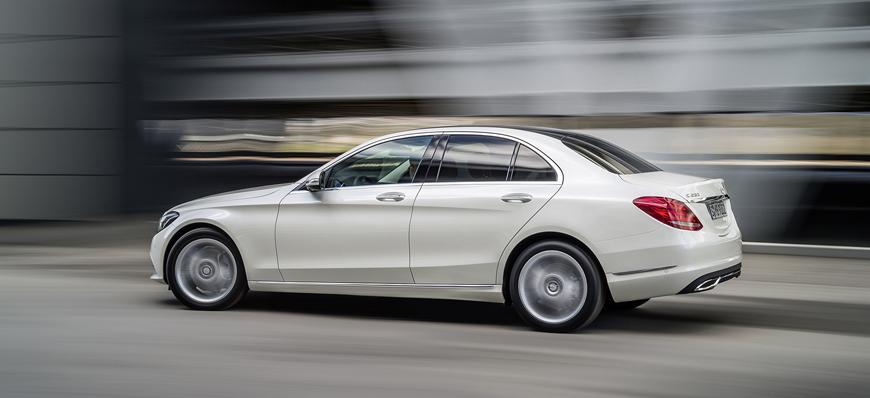You are here
Mercedes-Benz V250 Avantgarde (Extra Long): Luxury by large measures
By Ghaith Madadha - Sep 04,2017 - Last updated at Sep 04,2017

Photo courtesy of Mercedes-Benz
Replacing the outgoing Viano nameplate and re-adopting the V-Class moniker as of 2014, Mercedes-Benz presents the latest generation of highly practical large people carrier that is better than ever, and makes a compelling argument as an alternative to a saloon or SUV.
With more emphasis on design, luxury and technology, the new V-Class is an evolutionary improvement with noticeably better ride and cabin refinement, and handling ability and agility that was unexpected for a large van-based vehicle. Offered with a single smaller petrol engine in Jordan, the 2-litre turbocharged V250 offers better efficiency than its 3.5-litre V6 Viano predecessor.
A decidedly more charismatic and muscularly assertive design than its predecessor, the V-Class features an interplay between convex and concave shapes and surfaces at the sides and fascia, including more emphasised upper and lower creases along its flanks and smoother, better integrated bumper surfacing. Bearing strong familial resemblance to Mercedes’ passenger car model lines, the V-Class’ large upright grille features a three-dimensional tri-star badge flanked by twin chrome-like louvers and rising, stretched around headlights with a moodier aesthetic and LED elements that seem to frame the grille. A bulging bonnet and single louvre lower side intakes also lend more presence and elegance.
Cavernous and quick
Driven in the longest Extra Long version of three available lengths, with extended 3200mm wheelbase and longer rear overhang, the V-Class’s features a very subtly descending roofline and low CD0.31 aerodynamics for efficiency and low wind noise. It’s long, tall and wide rear loading bay and body allow for hugely cavernous cargo and passenger space, among the best in the MPV and van segments, and simply unmatched by SUVs or estate cars. At the rear, the new model features smaller, better integrated rear lights than the Viano, a low loading lip, electric tailgate and smaller glass hatch opening for more convenience for loading smaller items.
Offered in most markets with a 2.15-litre turbodiesel engine, the sole petrol V250 variant, available in Jordan, is powered by Mercedes’ now familiar and effective 2-litre turbocharged direct injection four-cylinder. Replacing its Viano predecessor’s 3.5-litre naturally-aspirated V6, the V250 develops 208BHP at 5500rpm and 258lb/ft torque throughout 1200-4000rpm, and is approximately capable of 0-100km/h in 9.4-seconds and a 210km/h top speed. At a 20BHP disadvantage to the Viano yet gaining 4lb/ft, the V250 nevertheless feels the more responsive, suitable engine and certainly more efficient engine, and benefits from a well-sorted and brilliantly geared version of Mercedes’ also familiar 7-speed automatic gearbox, in place of the Viano’s 5-speed.
Lively and
surprisingly agile
With quick-spooling turbo and responsive aggressively geared first and second ratios, the V250 feels sprightly and responsive from standstill, with turbo lag all but seemingly absent when driven in Comfort or Sport gearbox response mode. In Economy mode, revs are kept lower and gears higher, so naturally lag becomes slightly more apparent, but efficiency improves, and also benefits from taller top gears. Brawny, lively and versatile with muscular mid-range pull for inclines, overtaking and hauling, the V250’s engine belies a hefty 2055kg estimated weight, and is smooth, refined and willing to be revved hard to its redline, where engine roar is slightly more evident.
Another significant benefit courtesy of the V250’s downsized engine is that its front end feels noticeably lighter than its predecessor, with a crisper and more eager turn-in than expected from a large MPV, let alone one that is van-based. Tidy into corners with good front grip and little understeer when pushed too aggressively, the V250 Extra long is surprisingly agile through switchbacks, with its front engine and rear drive balance working in its favour. Meanwhile its long wheelbase provides good rear grip, and predictably telegraphed oversteer if provoked by a pivot to tighten a cornering line, or with too much throttle coming out of a corner.
Balance and comfort
Similar to other Mercedes passenger cars, the V250’s electric-assisted rack and pinion steering is positive, precise and eager to self-centre. And with better feel and feedback than some cars and many MPVs, vans and SUVs, the V250’s steering, upright driving position and balanced chassis, one feels involved and in the middle of the action. With a tauter and more rigid and refined feel to its construction and driving dynamic than the Viano, the V250 rides on independent rear suspension with variable dampers that soften to allow for supple ride comfort and tighten for comparably good body lean control through corners and to press wheels tautly into the tarmac.
Stable and refined at speed for its segment, the V250 is, however, in its comfort zone when cruising, while its optional Avantgarde trim 245/45R19 tyres provide a good compromise between control and comfort, and braking is reassuring. Riding well and smooth, the V250 can wallow very slightly over particularly choppy road surfacing, and on heavy braking, there is slight brake dive — both of which were less than expected. With a tight 12.5-metre turning circle, the V250 Extra Long is more manoeuvrable than its size suggests, but given its length and forward driving position, one often needs to turn-in later than intuitive when driving a car.
Manoeuvrable
and configurable
Enormous at 5370mm long, 1928mm wide and 1880mm tall, the V-Class Extra Long is, however, relatively easily manoeuvrable, especially when moving forward. To help with rear visibility, which can be tricky owing to size and height, the V250 Avantgarde version driven featured a 360° and reversing camera parking package. Meanwhile for overtaking and lane-changing manoeuvres, in which lower cars aren’t completely visible in big blind spots and, optional blind spot and lane assistance systems were invaluable. Over shoulder visibility is better when second row seats are configured to be front-facing, while bigger van-like side mirrors would be a welcome addition, even if at the expense of aerodynamics and aesthetics.
Refined, luxurious and superbly comfortable inside, the V250 Avantgarde has a classy and modern ambiance, with a contemporary dashboard, leather upholstery and steering, user-friendly infotainment and convenience features, soft textures, good fit and finish, tinted rear windows, and contemporary car-like dashboard and steering. In terms of practicality, the luxurious Avantgarde version features plenty of storage spaces and two — rather than one — huge electric and remote operable sliding doors to easily access the rear two seat rows. Accommodating 8-passengers with two rear bench seats, the 7-seat Avantgarde, however, featured twin middle row captain’s seats and a table unit, all of which are detachable and configurable along twin long flush rails.
TECHNICAL SPECIFICATIONS
Engine: 2-litre, turbocharged, in-line 4-cylinders
Bore x stroke: 83.1 x 91.9mm
Compression ratio: 9.8:1
Valve-train: 16-valve, DOHC, direct injection
Gearbox: 7-speed automatic, rear-wheel-drive
Power, BHP (PS) [kW]: 208 (211) [155] @5500rpm
Specific power: 104.5BHP/litre
Torque, lb/ft (Nm): 258 (350) @ 1200-4000rpm
Specific torque: 175.8Nm/litre
0-100km/h: 9.4-seconds
Maximum speed: 210km/h
Fuel tank: 70-litres
Length: 5370mm
Width: 1928mm
Height: 1880mm
Wheelbase: 3200mm
Track, F/R: 1666/1646mm
Overhang, F/R: 895/1045mm
Aerodynamic drag co-efficiency: 0.31
Unladen weight: 2055kg (estimate)
Steering: Electric-assisted, rack and pinion
Turning circle: 12.5-metres
Suspension F/R: MacPherson struts/semi-trailing arms, coil springs, anti-roll bars, variable damping
Brakes: Ventilated discs
Tyres: 245/45R19
Related Articles
With larger families and a particular penchant for the Mercedes-Benz brand, it is a wonder that the Mercedes V-Class and its Viano predecess
Enormously spacious and large, yet, manoeuvrable and economic — and bearing Jordanians’ most coveted automotive brand — it was only a matter
Launched in 2014 as Mercedes’ fifth compact executive saloon since the 190 first appeared in the 1980s, the C-Class has become a more luxuri


















